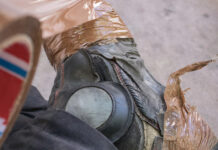In this discussion, we will be speaking about the fundamentals of footwear. Thousands of different styles and types of footwear exist but they all fall into categories that are based on their materials and construction. All of the basic categories of construction will be covered so that the reader has knowledge of these. With the terminology, there is going to be a learning curve and it may seem overwhelming at first. Take the time to absorb all the presented information that is being shown to you. As you read along, it will be easy to be able to readily see how footwear can be constructed.
Starting from the toes, the toe box is the first thing present. This is the part of footwear upper that covers the toes. A toe cap can be constructed to be reinforced or decorative and its position is over the top of the shoe. For men’s shoes, the effect can be decorative such as u-tip, wing-tip or straight-tip. For women’s footwear, it can be material such as leather for design and in children’s footwear it could also be a cap for protection against abrasion and wear at the toes. Our next item to look at is the vamp.
This is the forepart of the upper shoe and is commonly known as the part across the surface at the top of the ball. It is very important for both fitting and design of the shoe in question. The lace stay reinforces eyelets in all different types of shoes and is also considered in some styles to have a decorative element to it. The next item to look at is the tongue. This is the part of a lace up shoe that lies on the instep of the foot just behind the laces. It can be a feature that is padded for comfort.
Looking at the throat of the shoe, this is located behind the ball on the upper part of the shoe. For pumps, the edge becomes the throatline which is both a part of the design or silhouette and a location. Designs for the throat can include v-shape, square, and round, along with various other types. The quarter of the shoe designates a member of the backpart. This can be located by the horseshoe-shaped leather piece or other material cradling the foot or heel. This is joined to the forepart of the shoe. When speaking about the topline, this refers to the quarter’s top edge. The entire outer part of the shoe that does not include the sole is called the upper.
Shanks are the bridge or center section located between the front of the heel and ball line of the sole. Logger boots are a great example for a boot with a shank, because they are usually always made with one. Since it has a spring effect that is mild when weight is borne, this needs reinforcement and this is accomplished by using a slab of material, usually finger length of fiberboard, wood, metal or plastic inside the shank itself. While this area of the shoe cannot be seen, this piece is a crucial part of the shoe itself. Shoe heel is very obvious to see and look at.
In a man’s shoe, it contains a toplift which is the part that contacts the ground directly and heel base which is the part between the shoe and the toplift. The seat of the heel is the area located on the shoe inside and is where the heel rests. This identifier is mainly a locator rather than a part. In heels, especially high heels, the anatomy is very different. Usually, these are made from a single unit of plastic or they are stacked. In this area, the counter is usually a piece of leather that is stiffened and is located on the back of the shoe surrounding the heel. This maintains stability and shape.
Linings, you are probably already familiar with as it makes up different parts of the shoe inside. For example, the quarter lining reinforces the quarter piece. A sock lining covers the insole which is where the foot provides force. Vamp linings, cover the toe and forepart section of the inside of the shoe. Now let’s take a look at the outsole. This is the part of the shoe that is on the outside and contacts the ground every time that you walk. Along with this, the welt should be noted. It is material made of leather or other materials that is flat and narrow.
It attaches to the shoe by way of attachment to the upper and the welt to the insole of the shoe. The anchor of shoes is the insole, both structurally and otherwise. Many things are attached to the insole including welting, linings, heel counter, toe box and upper. Inlay is a removable material that has been prefabricated. This is located where the foot actually comes into contact with the shoe itself on the inside. For those that have work boots, the Bal design comes with a v cut at the throat of the shoe. This is tightened up with laces and eyelets ensuring a snug fit.
Another shoe that should be noted is the Blucher style of shoe. This is named after a military shoe devised and designed by Field Marshal Von Blucher. This shoe features two flaps containing either pieces or extension of the quarters that are placed into each side at the throat area and are tightened and secured by eyelets and laces. Athletic shoes are the last on the list. Different names are present for many of the different components of non-athletic shoes and carry specialized names for functions and components of their athletic shoes.




